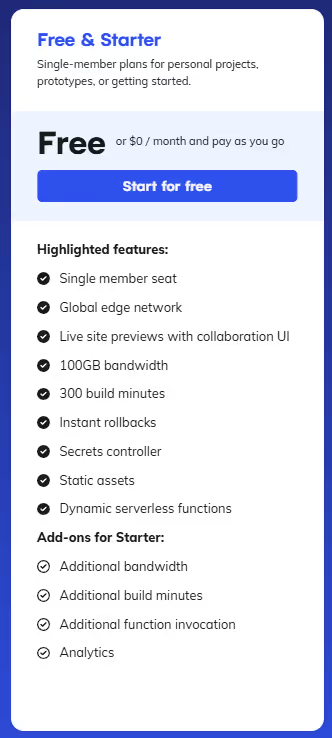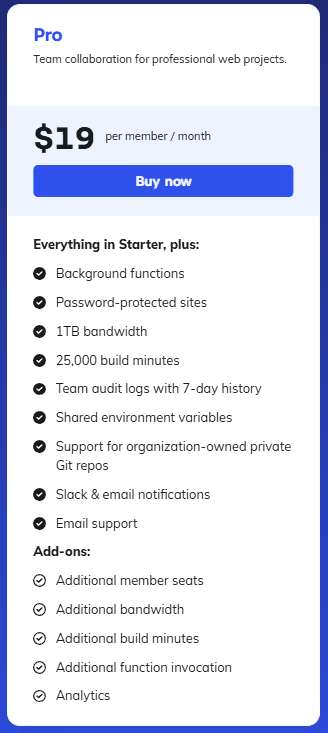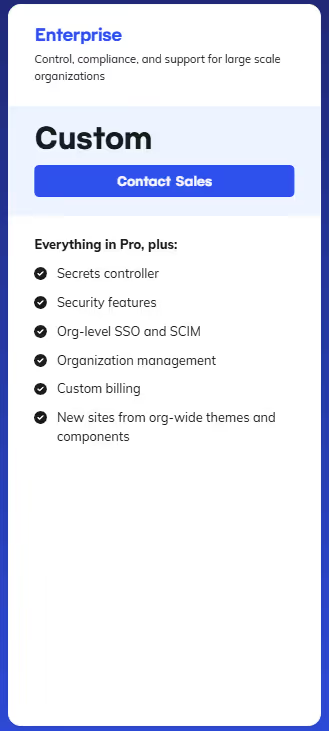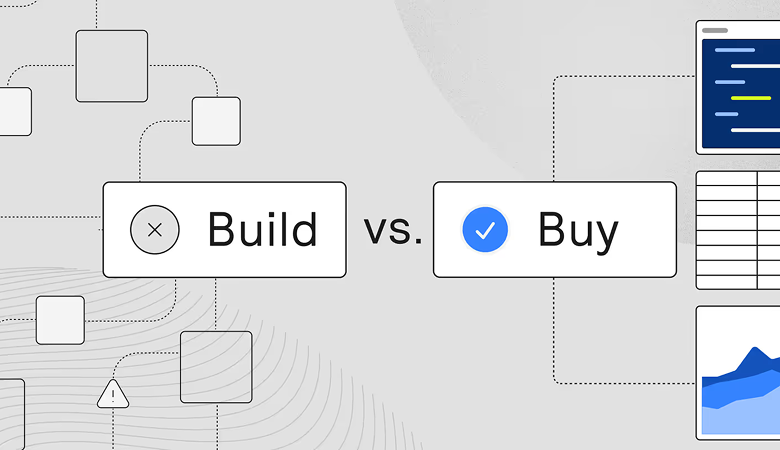Netlify is a web hosting and deployment platform designed for front-end developers. It offers automated Git-based deployments, continuous integration, serverless backend services, form handling, and global CDN delivery, all optimized for JAMstack architecture.
This post explains how Netlify pricing works, why usage-based models matter for platforms like it, and how Orb powers the billing infrastructure underneath.
Note: For the most up-to-date pricing, check Netlify’s official pricing page. Plan details may change over time.
Netlify plan-by-plan breakdown
Let’s zoom in on each Netlify pricing plan:
Netlify Starter plan

Netlify Free plan includes 100GB bandwidth, 300 build minutes, a single seat, and core deployment features at no cost.
Netlify's free tier, called the Netlify Starter plan, is truly free with no credit card required. It provides basic deployment features and enough capacity for testing, learning, or hosting low-traffic personal projects.
Netlify free plan features:
- Seats: 1 team member included
- Bandwidth: 100 GB/month
- Build minutes: 300/month
- Serverless functions: 125,000 invocations per site/month
- Edge functions: 1 million requests/month
- Storage: Up to 10 GB of free storage
- Features included: Git-based continuous deployment, global CDN, deploy previews, rollbacks, basic form handling, and identity services
Netlify Pro plan

Netlify Pro plan at $19/month adds 1TB bandwidth, 25,000 build minutes, team tools, private Git support, and email support.
The Netlify Pro plan is great for developers and teams that need collaboration features and increased limits. Netlify costs start at $19/month per user, billed monthly, which includes upgraded functions pricing.
Netlify Pro plan features:
- Seats: $19/month per user (multiple users allowed)
- Bandwidth: 1 TB/month
- Build minutes: 25,000/month
- Serverless functions: 125,000 invocations per site/month, with paid overages
- Background functions: Included (for long-running backend tasks)
- Security and collaboration: Password-protected deploy previews, shared environment variables
- Support: Email support, Slack/email deploy notifications
- Monitoring: 7-day audit logs
Netlify Enterprise plan

Netlify Enterprise offers custom pricing, SSO/SCIM, enhanced security, and org-wide controls for large-scale deployment needs.
Netlify enterprise pricing is customized based on the company’s needs and usage. Designed for high-scale or security-conscious applications, this plan includes enhanced security, support, and scalability.
Enterprise plan features:
- Pricing: Custom quote (based on usage and team size)
- Seats: Unlimited, with SSO and SCIM provisioning
- Bandwidth/builds: Custom quotas
- Security: Organization-wide SAML SSO, secrets management, role-based access control
- Infrastructure: Private networking options, better concurrency, custom deploy workflows
- Support: 24/7 support, SLAs, dedicated Customer Success Manager
- Compliance: HIPAA, SOC 2, and advanced DDoS protection available
Pro tip: For teams designing usage-based pricing for AI agents or other complex services, this free downloadable guide breaks down key strategies and metrics. You can also follow our implementation walkthrough to set it up yourself.
How Netlify’s pricing works
Netlify’s pricing model combines free access with tiered paid plans and usage-based add-ons. The tiers scale by member seats, build minutes, bandwidth, and enterprise-grade collaboration tools.
Add-ons cover extra usage like on-demand build minutes, serverless function execution, and edge request capacity. This gives teams flexibility to match costs to usage.
Remember: Pricing, plans, and features are subject to change. For the most up-to-date information, always refer to Netlify’s official pricing page.
Why is usage-based billing becoming the default?
Developer platforms, hosting providers, and AI tools are shifting away from pure subscription models. Traditional seat-based or flat-rate pricing doesn’t reflect the way customers actually consume resources like build minutes, serverless functions, or bandwidth.
Usage can stay light for weeks, then surge during a major release, making fixed tiers either too restrictive or too expensive.
Usage-based billing aligns cost with value. Businesses pay in proportion to the actual resources they use, avoiding overpaying during slow periods and keeping costs fair for smaller projects.
For providers, it protects margins during heavy workloads and ensures that revenue scales with the infrastructure demands of each customer.
The model also encourages experimentation and growth. Teams can start small without committing to a high-priced plan, then expand naturally as their needs grow. This flexibility benefits both sides: customers get a fair, scalable path to more resources, and companies can attract a broader range of users while still monetizing heavy demand.
How Netlify built a modern billing system with Orb
Netlify grew rapidly as it helped web developers build, deploy, and scale modern web applications. Their billing system needs began to change. Netlify sought a way to track complex usage-based pricing while staying flexible enough to test new pricing ideas.
Plus, they didn’t want to wait for engineers to build new features for testing.
Netlify chose Orb's raw event architecture and Orb RevGraph to transform how they handle billing. The system now processes usage events every second, tracking build minutes, bandwidth use, and other metrics without losing any data.
Their product teams use Orb SQL Editor to create new pricing models themselves. They test these models with Orb Simulations using their historical data before going live. Engineers don't need to get involved, which speeds up the entire process.
Orb has made a real difference for Netlify's day-to-day operations. Finance teams can see revenue data quickly and pull reports whenever they need them. Usage data flows automatically from Netlify's platform straight into billing, which eliminates manual work and cuts down on errors.
Now Netlify's engineers focus on improving their core product while business teams experiment with pricing to drive growth. The partnership gives Netlify the tools it needs to scale its billing as fast as its business grows.
The Orb difference
Orb reduces billing errors by turning raw usage data into fully auditable invoices. By performing calculations based on raw data, Orb ensures that your pricing updates are accurately reflected. Even as you evolve your pricing, invoices are automatically recalculated.
With Orb, teams define billing metrics from events (e.g., deployments, build minutes, function invocations) and use RevGraph to decouple usage data from pricing logic.
That separation lets you iterate on tiers, thresholds, and packaging without touching data pipelines. You can version plans, simulate changes before launch, and generate clear, traceable summaries that map every line item back to the underlying event.
FAQs
How much is Netlify?
Netlify pricing starts at $0/month for the Starter plan. The Pro plan costs $19/user/month, while Netlify enterprise pricing is customized for scale, security, and support.
Can I use Netlify for commercial use?
You can use Netlify for commercial use on all plans, including the free Starter plan. Netlify's terms of service allow commercial websites and applications.
The free tier provides enough capacity for small commercial projects, while paid plans offer increased limits and features needed for larger commercial deployments.
Is Netlify free for deployment?
Netlify is free for deployment through the Starter plan, which includes 100GB bandwidth and 300 build minutes per month.
You can deploy unlimited static sites without a credit card. The free plan includes core features like Git-based deployments, global CDN, deploy previews, and basic form handling.
Can I use my own domain on Netlify?
You can use your own domain on Netlify with both free and paid plans. The free Starter plan allows custom domain configuration.
Paid plans include additional domain management features like branch subdomains, domain redirects, and enhanced SSL certificate options for custom domains.
How Orb supports usage-based billing
Usage-based and tiered billing models require accurate metering, pricing flexibility, and systems that scale with product sophistication. Orb provides the infrastructure modern teams use to build scalable billing systems from the ground up.
Whether you're launching a free tier, billing for edge usage, or managing per-seat charges, Orb gives your team the foundation to experiment, launch, and scale pricing with full confidence. Here’s how Orb powers usage-based billing with precision, agility, and extensibility:
- Define billing metrics: Measure each event (deployments, build minutes, function invocations) with high fidelity so billing aligns with actual usage.
- Roll out and adjust plans without starting from scratch: With version-controlled pricing models and plans, you can update tiers, introduce new entitlements, or fine-tune thresholds without breaking your system or involving engineering.
- Run live pricing tests before making changes: Orb Simulations lets you preview the financial impact of new pricing before rolling anything out. You can test plan structures, overage thresholds, or function billing logic with real data from your product.
- Turn usage into transparent invoices: Orb reduces billing errors by turning raw usage data into fully auditable invoices. No surprises. Every line item maps back to a tracked event, making reconciliation easy for both users and finance teams.
- Measure and optimize your pricing over time: Use real product usage to analyze which features drive value, and adjust your model accordingly. By performing calculations based on raw data, Orb ensures that your pricing updates are accurately reflected.
- Connect your billing to the rest of your stack: Ingest data directly into your systems, power custom dashboards, or sync with accounting. Orb supports modern finance teams that demand audit-ready data and reporting. Even as you evolve your pricing, invoices are automatically recalculated.
- Use RevGraph to decouple usage data from pricing logic: Ingest clean, versioned events while defining pricing separately, so every calculation stays traceable, and changes don’t require data rewrites.
Ready to support dynamic pricing models with usage tiers, per-seat charges, or hybrid billing? Orb gives you the tools to do it without complex engineering. Explore our flexible pricing plans to see how you can design a model that fits your business, your product, and your users.



